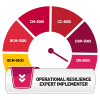Plausible Scenarios: Difference between revisions
No edit summary |
No edit summary |
||
| Line 10: | Line 10: | ||
'''''Note (2)''''': includes risk resulting from disruption to cyber, technology, people, third-party dependency, pandemics and disasters. | '''''Note (2)''''': includes risk resulting from disruption to cyber, technology, people, third-party dependency, pandemics and disasters. | ||
'''''Note (3)''''': is a realistic event that could disrupt the delivery of [Critical Business Services |critical business services], leading to unacceptable impacts. | '''''Note (3)''''': is a realistic event that could disrupt the delivery of [[Critical Business Services |critical business services]], leading to unacceptable impacts. | ||
'''''Note (4)''''': is used within operational resilience to stress test the impact tolerances that have been developed for critical [[Business Services|business services]]. | '''''Note (4)''''': is used within operational resilience to stress test the impact tolerances that have been developed for critical [[Business Services|business services]]. | ||
Revision as of 12:49, 12 October 2024
1. Plausible Scenario is a realistic event that could disrupt the delivery of critical business services, leading to unacceptable impacts.

Note (1): is used within operational resilience to stress test the impact tolerances that have been developed for critical business services and to identify weaknesses, vulnerabilities, and associated mitigating actions. Note (2): includes risk resulting from disruption to cyber, technology, people, third-party dependency, pandemics and disasters. Note (3): is a realistic event that could disrupt the delivery of critical business services, leading to unacceptable impacts. Note (4): is used within operational resilience to stress test the impact tolerances that have been developed for critical business services. Note (5): requires the board of directors to consider a broad range of severe but plausible scenarios, including:
| |||||||||||||||||||||||||||||||||||

